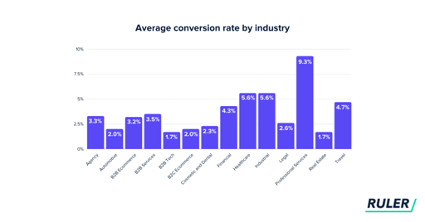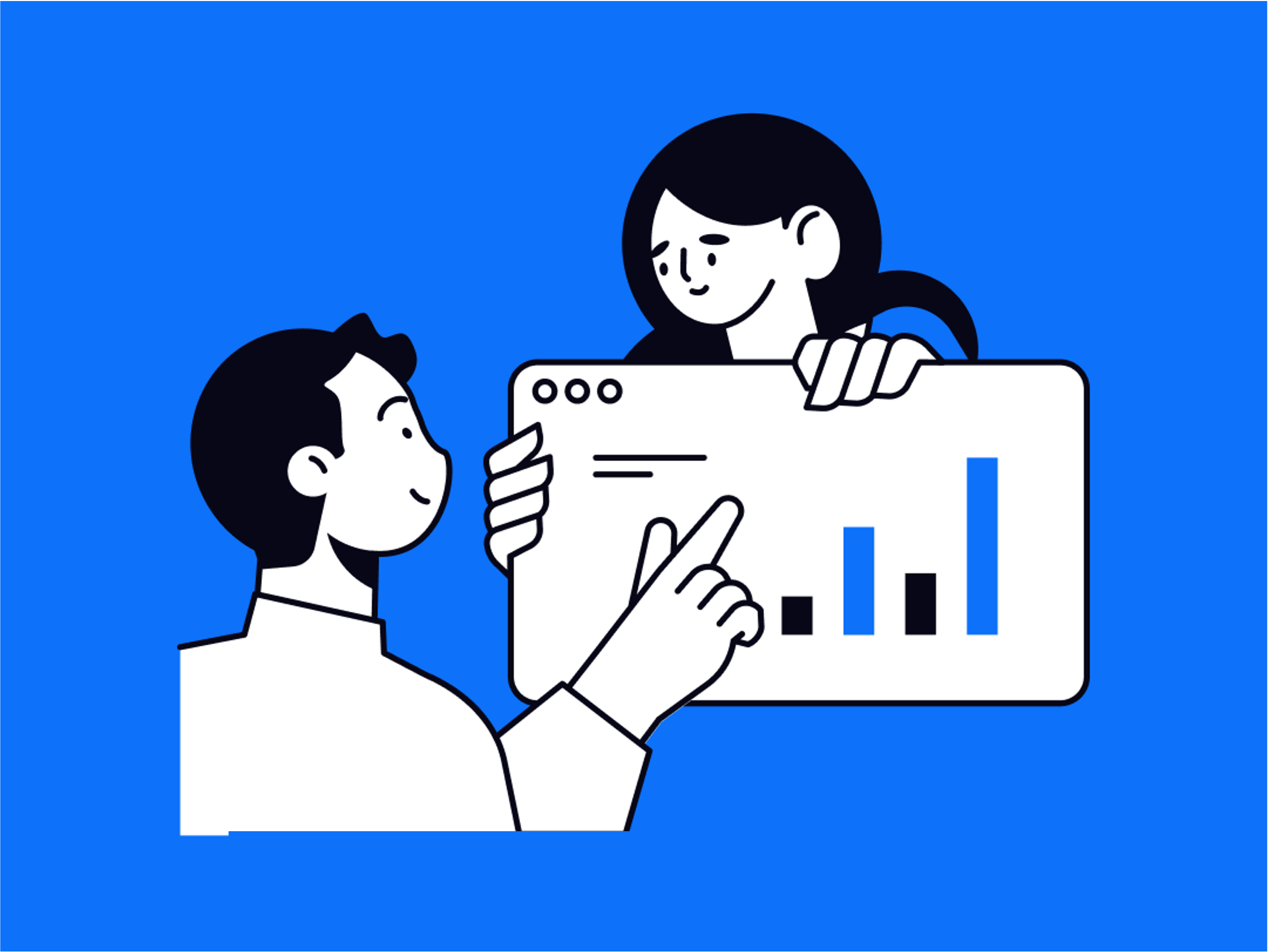Conversion rate is a key metric for every business, a reliable indicator of interest in the solutions offered and the effectiveness of marketing efforts. Learn how to measure it, why it is so important to track conversion rates regularly and how to improve this KPI.
What is the conversion rate and how is it calculated?
Conversion rate is a marketing metric that measures the percentage of visitors that take an action that is important for your business. It depends on the context and the platform you are using, but conversion rate can be defined as the ratio of engaged users to users who actually performed that action.
For example, if you just sent an email to 10.000 subscribers with a new product and got 500 people to finalize a purchase, the conversion rate was 5%. Similarly, if you run a physical store and get 10.000 visitors in a month of which 500 actually buy, the conversion rate will be calculated in the same way. In online stores, the conversion rate is usually measured as the ratio between transactions and sessions. For example, a ratio of one transaction for every ten sessions would be expressed as an e-commerce conversion rate of 10%.
However, campaigns can have other goals besides sales, such as filling out a form, subscribing to a newsletter, opening a specific page on a website, or following the company on social media. In any of these cases, the logic is similar: just divide the number of people impacted by how many performed the intended action. Therefore, the higher the conversion rate, the more effective a given campaign is.
Why is it important to measure and improve conversion rates?
Measuring the conversion rate is important because it shows if campaigns are being effective. After all, generating 100 sales in a universe made up of 1000 people is different from achieving the same absolute sales among 50.000 people. Conversion rate is also essential for calculating the return on marketing efforts – simply divide the sales generated by the amount invested in marketing. This way you can find out how much revenue is generated for each euro spent on campaigns.
As a general rule, a 3% conversion rate or higher is considered positive, with benchmarks differing from industry to industry, and depending on the channel used to communicate. For example, the global average in healthcare is more than three times that of real estate. However, in some channels, such as organic traffic and email marketing, the difference between the two sectors drops to less than half.

Source: Ruler
Another key factor is the price of the products – typically, the higher the average price of the products or services sold, the lower the conversion rate. This is due to the fact that the decision process for expensive products usually takes longer and includes more decision factors. This is especially true in B2B sales, where a deal takes an average of 3 months to complete. In more expensive products, you can have as much as a 9-month lead time from the moment the proposal is first pitched – which should be considered when analyzing the conversion rate. At the opposite end of the spectrum, the beverage and food sector is at the top of the online conversion rate, with an average of around 6%.
There are also other important variables, such as the information available online about a particular product. Almost 2 out of 3 consumers would rather look up information online than talk to a company representative, so companies with thoughtful websites and complete information online tend to have a higher conversion rate. In any case, measuring this KPI is essential to get an accurate X-ray of your marketing efforts. You can learn what is working well and what needs improvement – or even how to improve what is already bringing results.
How to increase the conversion rate?
If you have already measured the conversion rate and are not satisfied with the results, there are some best practices to follow to increase this metric. Here are 7 to implement right now.
1. Perform A/B testing
An A/B test is nothing more than comparing two versions of the same campaign, with slight variations. Both versions are available to the audience, with one part viewing version A, and the other viewing version B. The goal is to see which of the two versions generates more conversions.
It can be surprising to discover what just a few changes can do for conversion rates. Sometimes, a change in color or style, a different button or a different type of image can make the difference in the results of a campaign. So doing A/B testing is an effective way to find out what works best with your audience.
2. Focus on value proposition
A sound conversion rate relies on your ability to convince the audience that doing the desired action brings them benefits. So, one of the fundamental questions you should ask is why the audience should take the action. In other words, what does the person get out of it? Users will not make a purchase or subscribe to a newsletter without an obvious benefit for them.
Focus your communication on your value proposition, not on features and functionality. The benefit may not even be directly associated with the action – you can also add some extra incentives such as a coupon offer, a free webinar, downloadable tools, and other offers. If you communicate the benefit correctly, the user will be more likely to perform the desired action and thus increase your conversion rate.
3. Use mental triggers
There are some powerful mental triggers that can increase your conversion rate, as they exert a subtle but effective persuasive effect on users. For example, it is easy to ignore a request to follow a newsletter, but when the users realize that they can get access to content relevant for their daily life, or be among the first to receive promotions, they may feel tempted.
Some mental triggers have been studied for decades to help increase the conversion rate.
- Scarcity: Offering just a few units conveys the idea that a product is in high demand and therefore valuable.
- Urgency: Time-limited benefits appeal to the user’s sense of urgency to take advantage of the offer.
- Exclusivity: Limited editions or exclusive access make the user feel special and important.
- Loss: Communicating what the user will lose if they don’t perform the intended action is also an effective mental trigger.
However, it is important to use the right appeal (and in the right measure) for each strategy, so that the campaign does not become unnatural and thus end up having the opposite effect.
4. Use simple language
Convincing a user to take an action involves simple and objective communication. A complex language style peppered with technical terms can confuse and alienate the audience. The user should be able to tell within the first few seconds what they are expected to do. So, avoid the temptation to use sophisticated language to impress the audience, and adopt a more conversational stance. Choose verbs over adjectives to inspire users to act.
5. Reduce communication noise
Get rid of excess information in your campaigns to increase the conversion rate. Pop-ups, banners, and chatbots on websites can quickly become annoying when they start popping up simultaneously and take the focus off the conversion. It is not good practice to force the user to close a series of windows before they can see the content they expect to find.
So, focus only on what is conducive to the intended action and remove distractions. Avoid piling up unnecessary information. In fact, some conversion pages even eliminate the navigation menu, and others choose to increase the font size of important information to keep users focused.
6. Add customer reviews and ratings
Social proof is an important factor in increasing conversion rates. Users are more likely to perform an action if other people have also done so. So, adding reviews or ratings from other customers makes your product or service seem less risky, and can be the final persuasion to get the user to take action.
To generate reviews, be proactive right when a purchase is completed and ask users to leave comments and ratings. Existing customers find it positive that their opinion is valued, and it builds greater trust for the following users.
7. Provide the best payment experience
Globally, there are over 200 payment methods, including bank transfers, direct debit, digital wallets, cash on delivery, e-invoices, digital currencies, plus a variety of highly specific and locally preferred options. For now, credit and debit cards are still the most widely used payment method in the world, but digital wallets are gaining traction, as is Buy Now Pay Later with installment payments.
Even in contexts where card payments are still used, they are increasingly “dematerialized”, i.e. secured through a digital wallet or app. And the trend is that, in the future, new solutions will continue to emerge, and most users will continue to value the convenience of choosing their favorite payment method – key factors in improving the customer experience and increasing the conversion rate.
To convert, it is critical to pay attention to the payment experience. Checkout pages should include the payment methods your customers use (besides traditional payment methods) and be simple, fast, and intuitive. By implementing the easypay checkout, you will offer your customers a frictionless payment experience, adapted to your business image and ready to be used on any device. Easypay also provides several modules and plugins for the most popular platforms such as Shopify, Magento, Woocommerce or Prestashop and plugins for invoicing software like PHC Go and PHC CS.
Increase your conversion rate with easypay
These are just a few strategies that will help increase your conversion rate. Contact us and find everything you need to elevate your customers’ shopping experience and increase your conversion rate.
